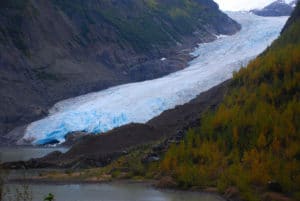Featured photo: Welcome to Hyder, by Tom Dell
This week we’re headed to Hyder, Alaska – the coolest road trip destination you’ve never heard of.
What is Hyder? It’s a town – a hamlet, really – in the far southeastern corner of Alaska. Residents call it “the friendliest ghost town in Alaska,” but it’s not a ghost. Somewhere around 80 or 90 people live here.
What makes it cool? It’s a unique combination of natural attractions and political geography.
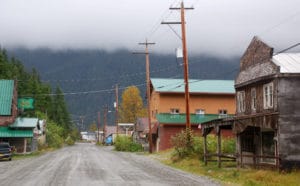
Hyder sits at the head of 100-mile-long Portland Canal, which marks the U.S.-Canadian boundary. That makes it Alaska’s southernmost and easternmost town. There’s no road connecting it to the rest of the state. However, there is a road connecting it with Canada, which leads to its unusual political geography. More about that in a paragraph or two.
Glacier-clad mountains rise steeply from sea level to over 6,000 feet. Waterfalls are everywhere. To get there, you drive within 300 yards of a glacier on a paved highway. The hiking, kayaking and salmon fishing are superb. And the wildlife viewing, especially for bears, is extraordinary.
Bizarre political geography
Hyder’s political geography is bizarre.
“As a result of its geographic isolation, Hyder functions as America’s only de facto outpost of Canada,” writes Ken Jennings in Conde Nast Traveler.”
Just a short mosey away is neighboring Stewart, British Columbia, with a population of 700. Hyder shares Stewart’s time zone, area code, electricity and currency. Policing is done by the Mounties. Kids from Hyder went to Canadian schools until this year, when the town qualified with 12 children to get a teacher supplied by the State of Alaska.
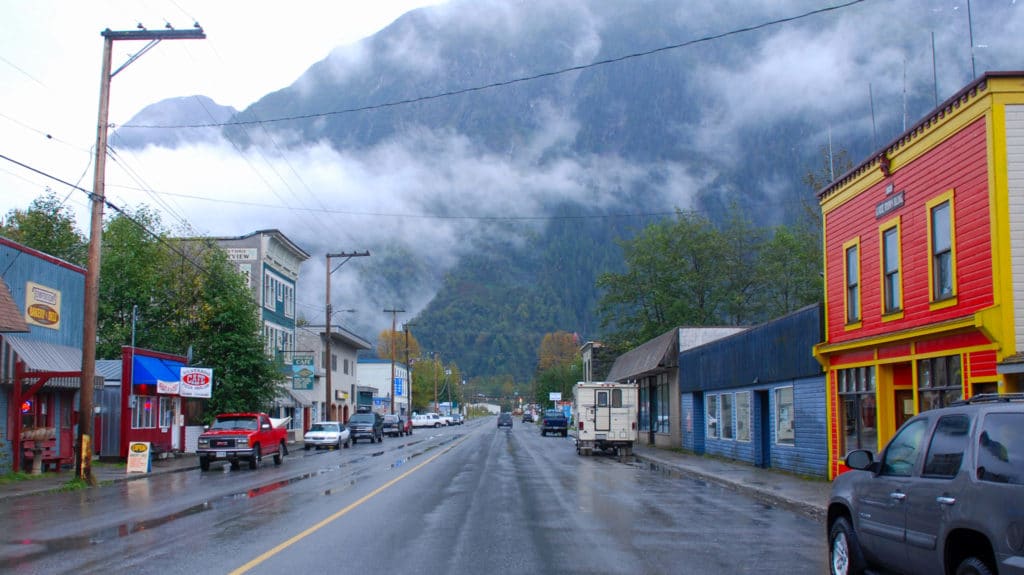
Hyder is the only place you can legally enter the United States without identification. However, the Canadians have a checkpoint for vehicles leaving Hyder. So, no, visitors don’t need a passport to visit Hyder, but they do need one to leave it.
If you live in Hyder, you go to Canada to buy groceries, hardware or gasoline, do your banking, or see a doctor. The sole exception is Hyder’s post office, which operates on Alaska time and accepts only U.S. dollars.
Bear viewing For $5
Unlike their neighbors in Stewart, Hyderites openly carry weapons. The reason for that – and also the biggest draw for the estimated 100,000 people who visit here every year – is bears. There are more bears than people, and the bears roam just about everywhere. When I was there, a long-time ranger with the U.S. Forest Service had recently been killed by a giant brown bear.
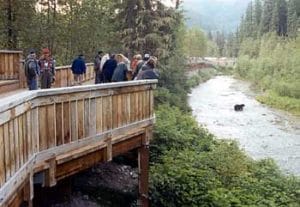
Hyder and Stewart are mining towns settled just after the turn of the 20th century. After a series of booms and busts, the economy has shrunk and re-focused on tourism.
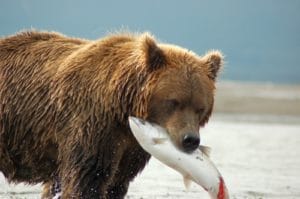
What draws most visitors here is the annual salmon run on nearby Fish Creek, which occurs in July and August. The Tongass National Forest has built a ¼ mile viewing platform, so visitors can safely observe and photograph the bears that fish for salmon here. The platform is even accessible for wheelchair-bound visitors. Many people spend thousands of dollars for a similar bear viewing experience elsewhere in Alaska. Here, it costs $5 for a day use fee (free if you have a federal senior pass). Hours are 6 a.m. to 10 p.m. A ranger/naturalist is usually on duty to answer questions. Facilities include a restroom. For more information, go to www.fs.usda.gov/detail/r10/specialplaces/?cid=fsbdev2_038787
All roads beyond the border are gravel. From the border, drive west to the T-junction, turn right, then go 3 miles. Beyond the viewing platform, the road curves back into Canada, then climbs to a viewpoint overlooking spectacular Salmon Glacier – one of B.C.’s biggest and most impressive. That, of course, is on a rare clear day. In most of southeast Alaska, it’s raining, just finished raining, or is about to rain. Or, all three.
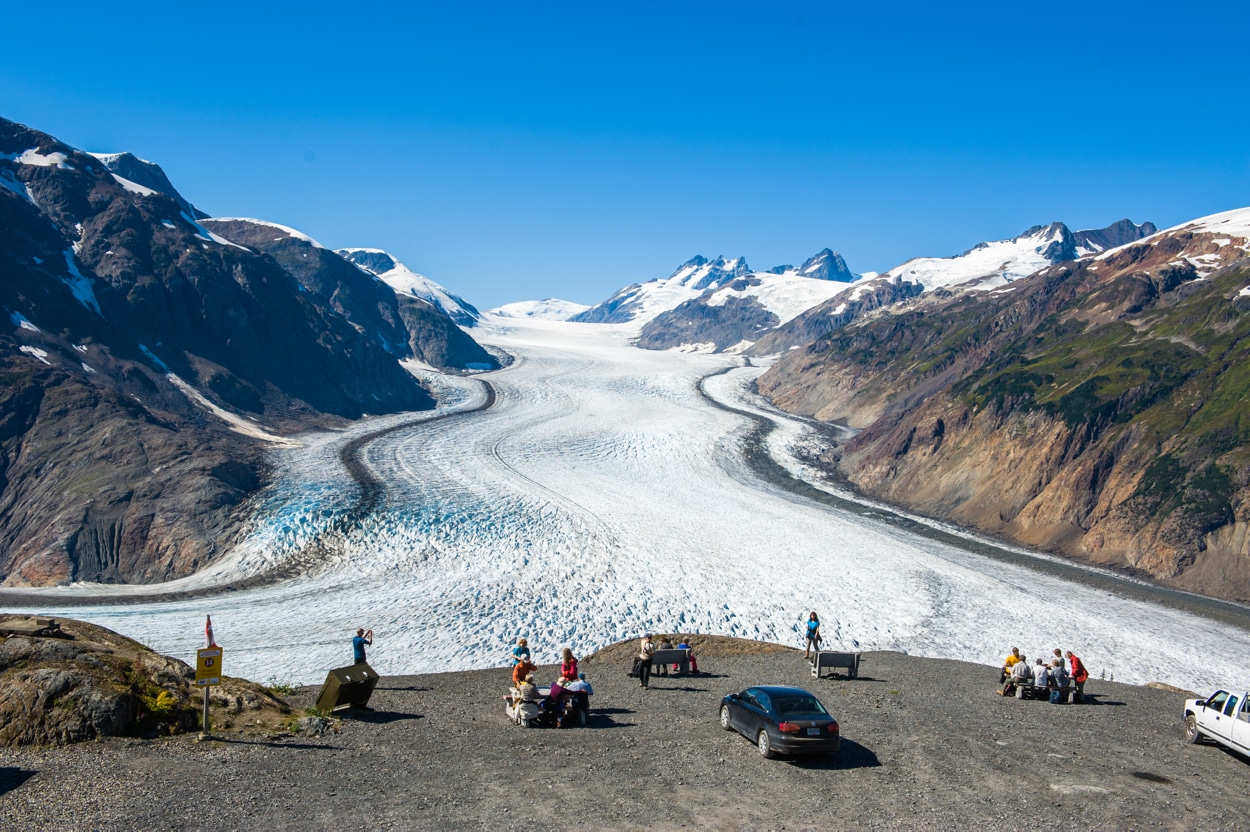
Logistics
You’ll find accommodations in both Hyder and Stewart, (I suggest reservations during bear viewing season.) I stayed at Hyder’s Grandview Inn, which was fine. Places to camp are easily found. For dinner, however, the Grandview Inn’s owner recommended the dining room at the King Edward Hotel in Stewart, so I had to go through Canadian customs inspection en route to my evening meal. Gas and groceries, as mentioned earlier, are also in Stewart.
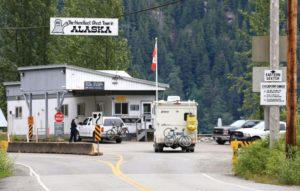
Hyder has a couple of gift shops and bars, one of which invites you to “get Hyderized” by drinking a shot of 150-proof grain alcohol. (I passed on doing this.)
The jumping-off point for Stewart and Hyder is the city of Prince George, B.C., which is easily reached via Vancouver for West Coast road trippers, or from Calgary or Edmonton for those coming from the Midwest. You can also fly to Prince George from Vancouver via Air Canada or Westjet.
From Prince George, take the Yellowhead Highway (BC 16) west for about 300 miles, drive north on the Cassiar Highway (BC 37), then head 40 or so miles on BC 37A to Stewart. Along the way, Highway 37A passes right in front of Bear Glacier. The turnoff for Hyder is clearly signed. Pavement ends at the border.
And this week’s issue of Road Trips with Tom ends here. On February 5, we’re heading back to Utah to visit awesome Canyonlands National Park.
Thanks for reading!
